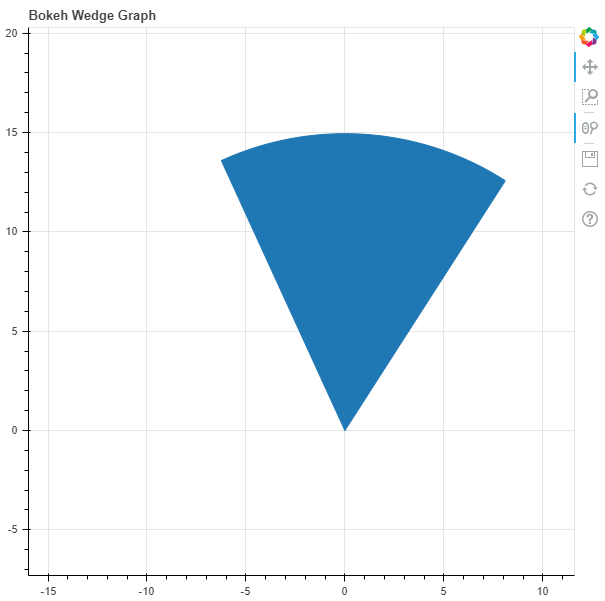Bokeh es una visualización de datos interactiva de Python. Representa sus tramas usando HTML y JavaScript. Se dirige a los navegadores web modernos para presentaciones que proporcionan una construcción elegante y concisa de gráficos novedosos con interactividad de alto rendimiento.
Bokeh se puede utilizar para trazar cuñas en un gráfico. El trazado de cuñas en un gráfico se puede hacer utilizando el wedge()método del plottingmódulo.
trazando.figura.cuña()
Sintaxis: cuña (parámetros)
Parámetros:
- x : coordenadas x de los marcadores de cuña
- y : coordenadas y de los marcadores de cuña
- radio : radio de los marcadores de cuña
- radio_unidades: unidad del radio de los marcadores de cuña, el valor predeterminado es radianes
- start_angle : ángulo para iniciar los marcadores de cuña
- start_angle_units : unidad del ángulo para iniciar los marcadores de cuña, el valor predeterminado es radianes
- end_angle : ángulo para terminar los marcadores de cuña
- end_angle_units : unidad del ángulo para terminar los marcadores de cuña
- dirección: dirección de los trazos, por defecto es en sentido antihorario
Devoluciones: un objeto de clase
GlyphRenderer
Ejemplo 1: En este ejemplo, utilizaremos los valores predeterminados para trazar el gráfico.
# importing the modules
from bokeh.plotting import figure, output_file, show
# file to save the model
output_file("gfg.html")
# instantiating the figure object
graph = figure(title = "Bokeh Wedge Graph")
# the points to be plotted
x = 0
y = 0
# radius of the wedge
radius = 15
# start angle of the wedge
start_angle = 1
# end angle of the wedge
end_angle = 2
# plotting the graph
graph.wedge(x, y,
radius = radius,
start_angle = start_angle,
end_angle = end_angle)
# displaying the model
show(graph)
Producción :
Ejemplo 2: en este ejemplo, trazaremos varias cuñas con varios otros parámetros.
# importing the modules
from bokeh.plotting import figure, output_file, show
# file to save the model
output_file("gfg.html")
# instantiating the figure object
graph = figure(title = "Bokeh Wedge Graph")
# name of the x-axis
graph.xaxis.axis_label = "x-axis"
# name of the y-axis
graph.yaxis.axis_label = "y-axis"
# the points to be plotted
x = [0, 5, 0]
y = [0, 5, 5]
# radius of the wedges
radius = [15, 10, 5]
# start angle of the wedges
start_angle = [1, 2, 3]
# end angle of the wedges
end_angle = [2, 4, 6]
# color value of the wedges
color = ["yellow", "red", "purple"]
# fill alpha value of the wedges
fill_alpha = [0.9, 0.7, 0.5]
# plotting the graph
graph.wedge(x, y,
radius = radius,
start_angle = start_angle,
end_angle = end_angle,
color = color,
fill_alpha = fill_alpha)
# displaying the model
show(graph)
Producción :